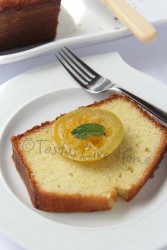Hi Everyone, A pound cake is the kind of cake you either like or dislike. I used to be firmly in the latter category, until now.
Pound cake is my mother’s absolute favourite kind of cake and it made a regular appearance on her baking schedule. I always found it to be, well, plain. It held its most appeal, to me, only when it was still warm. The whole truth is this, I have never been a lover of cakes of any kind, well except Granny Harris’ rum-fruit cake, which she only made once a year, and that was when I was a kid. However, it seems now, as I am getting older that my taste for certain things is changing, and, wait for it… I am into citrus pound cakes! Whhaat?! Yes, the same type of cake I thought to be so plain! (Shaking my head).

I use the term citrus for the cake because you can use oranges, lemons, limes, grapefruit, tangerines, pomelo (aka shaddock) or tangelo (a hybrid of tangerine and pomelo). You can even use passion fruit. However, if you are using limes, grapefruit, pomelo or passion fruit, you’ll need a little extra sugar to cut more of the acidity.
Here are the few extra steps needed to make the cake worth of your time and taste buds.


Zest. The zest is the outer skin of the fruit where all the essential oils are. Once you’ve grated and removed the zest from the fruits, using your fingers, rub the zest and sugar together. What you are doing here is essentially creating a flavoured sugar. You will notice that the sugar becomes moist and highly fragrant. Most recipes call for the zest to be added in later in a batter but flavouring the sugar and then creaming the butter and sugar together, make the flavour more deeply integrated.
The juice. When you’re done zesting, squeeze the fresh juice of the fruits. You will need some of the juice to add directly to the batter and to make a flavoured syrup.
The syrup. You will make the citrus syrup while the cake is baking. It is to be brushed on to the hot cake when it comes out of the oven. This step does not only intensify the flavour of the cake but it adds moisture too.
Added richness. Sour cream, whole milk yogurt and buttermilk – all add creamy richness and moisture when incorporated into batters when baking. If you do not have any of these items on hand, don’t fret, homemade buttermilk is easy to make. Take ¼ cup of evaporated milk or heavy cream and mix it with 1 teaspoon fresh lime or lemon juice and let it sit at room temperature for ½ an hour. If using grapefruit or pomelo juice, add 1 ¼ teaspoons. Passion fruit juice is acidic too, use 1 ½ teaspoons.
A bonus – candied citrus. While this step is completely unnecessary, you can use the time the cake is in the oven to make a condiment that you can either serve with the cake, any other dessert, or incorporate in other baking goods. I’ll tell you how to make this tomorrow in In Good Taste.
Let’s get to it, shall we? For this cake, I used oranges.
You will need:
- 1 ¾ cups all-purpose flour, plus extra to dust pan
- ½ teaspoon baking powder
- ¼ teaspoon heaped fine (table) salt
- 1 cup plus 1 tablespoon white sugar
- 1 ½ tablespoons orange zest
- 1 cup (8 oz.) unsalted butter, room temperature, plus extra for baking pan
- 5 large eggs, room temperature
- ¼ cup sour cream, buttermilk or whole milk yogurt
- 2 tablespoons orange juice
For the syrup, you’ll need:
- ¼ cup orange juice
- ¼ cup white sugar
Here’s what to do for the cake:
- Preheat the oven to 325 degrees F.
- Butter a 9 x 5 loaf pan and then dust with flour, turn over the pan and tap it gently to remove the excess flour; set aside.
- Mix together the flour, baking powder and salt and set aside.
- Mix together the sour cream (or whatever you are using) along with the juice and set aside.
- Rub and mix together the zest with the sugar until the sugar is fragrant, moist and the colour has changed, reflecting the hues of the zest.
- Add the butter to the flavoured sugar and cream the two for 4 – 5 minutes using a hand mixer, longer if working by hand.
- Mix in the eggs two at a time and be sure the eggs are fully incorporated at each stage of addition.
- Add the dry ingredients (flour mixture) and wet ingredients (sour cream & juice) to the batter by alternating – start and finish with the dry ingredients. Make 3 additions of the dry ingredients and 2 addition of the wet ingredients.
- Transfer the batter to the prepped pan, and lift it and tap it on the counter to remove any bubbles, smooth the top and transfer to the oven and bake for 60 – 65 minutes or until a skewer inserted comes out clean.
- While the cake is baking, make the syrup. Add the juice and sugar to a small saucepan and place on medium heat. Stir to dissolve sugar and then let come to a boil. Cook for 1 minute then shut off heat and remove from stove; set aside.
- When the cake is done, remove it from the oven and let cool in pan for 10 minutes then remove it and transfer to a wire rack inserted into a sheet pan. Brush all over the cake the syrup – top and sides. Let cool completely.
- Serve at room temperature. This cake improves in flavour every day thereafter but I am sure it won’t be around for long. Make it and invite a couple of friends over for a cuppa.
Enjoy!
Cynthia
cynthia@tasteslikehome.org





